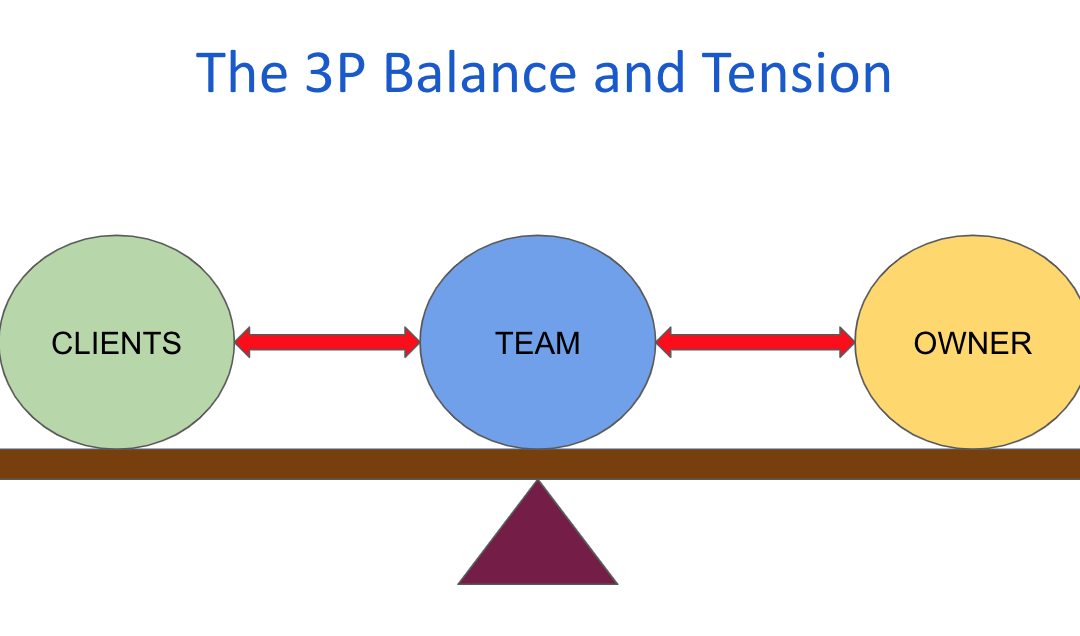When I engage with business owners, I always ask, “Why did you go into business?” Most answers are rooted not in the monetary aspect but in the freedoms that business owners believe money can buy. Often, the real goals are time, freedom, and the ability to focus on what you are truly passionate about.
While revenue is essential, it’s only a part of the equation. Many business owners mistakenly equate higher profits with more freedom, but the reality often proves otherwise. If your business journey has deviated from these original objectives, it’s time to refocus.
Growing endlessly may not bring you closer to what you genuinely wish to achieve.
Here’s a more holistic approach instead. It centers around three main aspects: Clients, Team and Owner.
I talk about this in my YouTube video,
Implementing the 3P Filter
One practical way to utilize the 3P model is by using it as a filter for all business decisions. Before implementing any changes, ask yourself, “Will this improve outcomes for all three groups—clients, team members, and myself?” This focus ensures that the changes you make have the most significant overall impact, aligning with not just profit motives but also personal aspirations and team well-being.

What is the 3P Balance Intention?
The 3P (As In “Three People”) Stands For:
- Clients
- Team Members
- Business Owner
Balancing these three pillars is the secret sauce to long-lasting business success.
Let’s dissect the dynamics. Client satisfaction remains paramount, as they are the revenue drivers. However, over-prioritizing clients can be a double-edged sword. Exceptional service levels require extensive resources, often stretching your team thin and escalating operational costs. This imbalance undermines both team morale and financial stability, jeopardizing the entire business model.
Clients: The Revenue Drivers
- Importance: Keeps the cash flow going.
- Risk if Over-Prioritized: Drains resources, hurts team morale, raises costs.
- Balance Strategy: Align service offerings to real expectations, not imagined ones.
Conversely, focusing on employee satisfaction and work-life balance can have its own pitfalls. While flexibility and team well-being are vital for productivity and retention, these must not compromise the level of service your clients have come to expect. Too much priority on team needs can dilute service quality, eroding client trust over time.
Team: The Backbone of the Business
- Importance: They turn plans into action.
- Risk if Over-Prioritized: May decrease service quality and client trust.
- Balance Strategy: Keep lines of communication open to understand their real needs.
As the business owner, you are the one balancing this equation. Your actions and decisions set the organizational tone, directly affecting how clients and team members interact with the business. You must carefully build a business model that equally weighs the needs of all three stakeholders. Open communication is the key here. Accurately gauge client expectations and adjust your service offerings accordingly, but without overwhelming your human resources. Likewise, maintain a continuous dialogue with your team to understand their needs and operational challenges.
Business Owner: The Decision-Maker
- Importance: Sets the tone and direction of the business.
- Role in Balance: Must weigh the needs of Clients and Team equally to set a sustainable business model.
This balanced approach not only enhances client retention but also fosters team loyalty—both essential factors for achieving business profitability.
Strive for a business model that is not just revenue-centric but also values-driven. A balanced, well-considered approach to stakeholder satisfaction is the most reliable pathway to not just profitability but also to a fulfilling, sustainable business venture.
| Stakeholder | Importance | Risk of Over-priotization | Strategy of Balance |
| Clients | Revenue Generation | Drains Resources | Align service offering to real expectations |
| Team | Executes Plans | Dilutes Service Quality | Open and ongoing communication |
| Business Owner | Decision-making | Could misalign priorities | Weigh needs of clients and team quality |
Look, business isn’t static. It changes all the time. As you grow, problems will pop up. Maybe your clients want more, or your team is struggling to keep up. You, as the boss, need to make tough calls. Suppose you bring in new software to stay ahead. Your team has to learn it fast, or customer service may dip for a bit.

That’s why adaptability is vital for any business. But most of the time, a company’s own culture often becomes its biggest roadblock. This is especially true for businesses over decades old. A history of success can breed complacency. This mindset creates a rigid structure that resists change, making it hard to quickly adapt.
I recall a friend in the Real Estate sector, who despite having a successful business, faced internal resistance when trying to evolve to meet industry changes. His team’s reluctance slowed down the process, causing frustration and lost opportunities. That’s why I think it’s crucial to establish a culture that not only tolerates but embraces change. Doing so prepares your team and your organization to pivot when necessary, rather than becoming a hindrance. Knowing your team’s openness to change in advance gives you the foresight needed to navigate challenges effectively.
Why is 3P Balance and Tension important?
In the business arena, every interaction is fundamentally an exchange with different people—your customers,team members, and you as the owner. Your clients give you time, money and loyalty in return for your products or services. These exchanges are not just transactions; they are defining moments that shape how your audience perceives your business.
The quality of these exchanges can either make or break your venture’s growth trajectory. Simply put, the better the exchange, the higher your business climbs on the ladder of success.
This leaves you no other way but to deliver…
The Gold Standard: Exceeding Expectations

Reflect for a moment—when was the last time you raved about an exceptional service experience? More than likely, it was because the service went above your expectations. And what did you do? You probably couldn’t wait to tell your friends, and you definitely planned to go back, most likely with more people. This is the sign of a high-quality exchange—a service interaction so impactful it surpasses what was anticipated.
Businesses that excel don’t just aim for this occasionally; they incorporate this ethos into their standard operating procedures.
To appreciate the nuances of business exchanges, let’s categorize them into three distinct levels:
Below Expectations are those lackluster interactions that disappoint customers, putting a dent in your business reputation. On the other hand, Normal Expectations represent the bulk of exchanges; they meet basic standards but rarely impress, leaving customers indifferent and your business in a state of mediocrity. Finally, Beyond Expectations are the gold standard. These are the interactions that not only meet but delight and astonish your clientele. Contrary to popular belief, you don’t need to make grand gestures to achieve this level; it’s often a series of small, well-executed details that elevate an exchange from merely average to truly exceptional.
Here is a table to understand better what I meant:
| Tier of Business Exchange | Description | Impact on Business |
| Below Expectations | Exchanges that are so subpar they leave customers or clients unsatisfied, hurting your reputation. | Negative; risk of losing customer loyalty. |
| Normal Expectations | Exchanges that meet the basic criteria but don’t impress, leaving customers feeling indifferent. | Neutral; maintains the status quo. |
| Beyond Expectations | Exchanges that go above and beyond, delighting and astonishing customers. | Positive; enhances reputation and fosters loyalty. |
The quality of these interactions directly correlates with your business’s potential for growth and longevity. Aim not just to meet but to exceed expectations at every opportunity. If you do, you can potentially avoid happening this to you:
The 3P Case of Blackberry
BlackBerry was the go-to brand for business smartphones in the early 2000s. They had a product that customers loved, a dedicated workforce, and an owner-driven vision. Then came the iPhone, and suddenly the smartphone market changed dramatically. BlackBerry made crucial mistakes in responding to these shifts, offering a real-world example of what can go wrong when stakeholder balance is lost.
Critical Missteps
- Customers – BlackBerry misread its customers’ evolving needs. They thought business-focused features like a physical keyboard and secure email were enough. Meanwhile, customers were looking for more versatile devices with better internet and app capabilities.
- Team – There were divisions within the company. Some wanted to innovate and catch up with the changing market, but leadership clung to the old ways. This led to delays in development and a loss of enthusiasm among employees.
- Owner – Upper management’s sluggish response to market dynamics cost the company valuable time and competitive advantage.
The consequences were severe: BlackBerry lost its market share to more adaptive competitors, employee morale plummeted, and a workforce reduction became inevitable. The company eventually pivoted from hardware to focus on software and services.
The collapse of BlackBerry serves as a critical lesson for any business professional. It highlights the absolute necessity of balancing the needs of customers, employees, and owners. Neglecting any of these key stakeholders risks not only profitability but the very survival of the business. In today’s volatile market, this triad of interests demands your constant attention. Ignoring this is not just bad business, it’s a roadmap to failure.
Final Words
In summary, the 3P Balance of Clients, Team Members, and Business Owner is crucial for enduring business success. The BlackBerry case exemplifies the risks of neglecting this balance. As a business leader, your role is pivotal in maintaining equilibrium among these stakeholders. Open communication and a culture that embraces change are key. Failing to balance these critical elements jeopardizes not just profitability but the very survival of your business. Keep your focus on this essential triad to navigate the complexities of the modern business landscape effectively. If you want to know how I balance my team, clients and my well-being to create the life and business that I wanted, sign up to my newsletter: https://idealbusiness.invizbiz.com/newsletter

